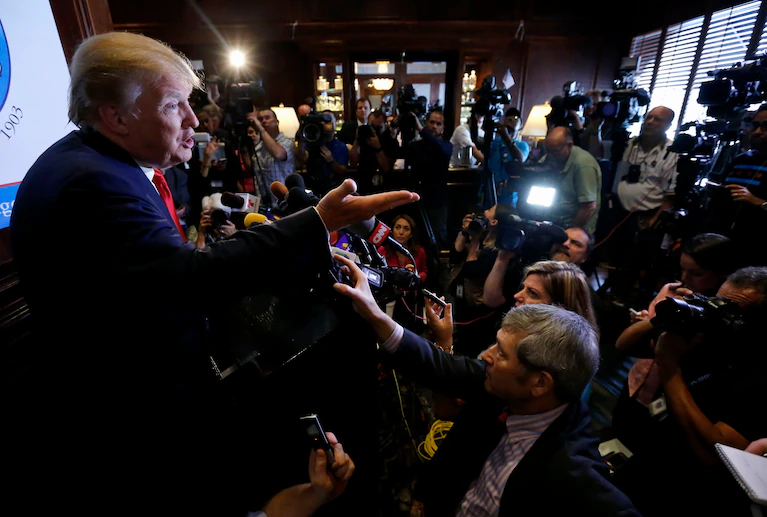People mainly know Spiro Agnew for the scandals of his tax evasion that made him give up his post as Richard Nixon’s Vice President. However, His political legacy is that he waged a campaign of intensity never seen before, going on and on for over four decades. Note that he called the mainstream media biased, liberal, and elitist. Before Agnew’s efforts, anti-media sentiment had been simmering on the right. Agnew specifically targeted the Big Three television networks, alleging they represented an unprecedented concentration of power over American public opinion.
Agnew, with unwavering persistence and aided by talented Nixon speechwriters like William Safire and Pat Buchanan, coined several memorable phrases. Among them was the alliterative expression “nattering nabobs of negativism.” This campaign laid the groundwork for a lasting narrative that depicted the mainstream media as partial. Rarely has a coordinated political effort seen such success. As a result, editors, journalists, and producers have been on their guard, wondering if they are being too cautious about reports and stories that look like they might express a conservative perspective.
How Exaggerated Coverage of Presidential Frontrunners Turn the Media into Slobbering lapdogs for Trump?
Image credit- Jabin Botsford/The Washington Post
However, the 2016 campaign witnessed a robust progressive counterattack against media reluctance to challenge the right. The coverage of Donald Trump became a focal point for a new crisis of credibility. One aspect of concern is Trump’s disproportionate access to television time during the primaries, overshadowing attention given to his competitors. Liberals argue that Trump is facing a lower standard of criticism than Hillary Clinton. Consequently, each new Trump scandal receives relatively brief attention. On the other hand, the same old Clinton scandals appear repeatedly.
Granting Trump extensive television time during the primary campaign is not directly part of the liberal-conservative debate. However, it remains an issue for which the media should take accountablity. This unequal exposure disadvantaged other Republican presidential candidates and underscored a prioritization of ratings overbalance. The coverage of Trump and Clinton does raise concerns about a media that, hyper-aware of conservative criticism, may now be overcompensating in the opposite direction.
It is not a plea for the media to refrain from holding Clinton accountable. Rather, it is a call for journalists to critically assess whether they have crafted a narrative around Clinton that portrays her as less trustworthy than Trump. Note that there is overwhelming factual evidence that he engages in falsehoods more frequently than she does.
How Media Reacts to Trump’s Lies?
Image credit- Jabin Botsford/The Washington Post
Nicholas Kristof, a New York Times columnist, highlighted PolitiFact’s discovery that 53 percent of the Trump statements they examined were “False” or “Pants on Fire” howlers, in stark contrast to Clinton’s 13 percent. According to Kristof, there is no comparison with Trump in terms of the frequency of false statements.
Putting ideological considerations aside, Marshall argued that Trump’s repeated and bold falsehoods put a considerable strain on the media’s traditional rules and practices. Despite evidence from 2002 and 2003 showing Trump’s support for the Iraq War, he persistently claims to have opposed it. Furthermore, Trump is the leading proponent of the birther conspiracy theory, suggesting Barack Obama was ineligible for the presidency. However, he falsely asserted that Clinton initiated the entire controversy.
Journalists were hesitant to label Trump as a liar, even when said falsehoods. However, the calculated nature of his birther announcement sparked what Margaret Sullivan, a media columnist for The Washington Post, described as “some long overdue indignation” among reporters. There were noticeable signs, evident in headlines and news stories, that the remaining reluctance to use the term “lie” about Trump was diminishing.
Conclusion: Spiro Agnew’s Ghost
Criticism from liberals regarding the media is often brushed aside as partisan, and liberals indeed express frustration. They feel bad about what they perceive as the right’s successful partisan media campaign that has influenced journalistic institutions. Liberals are also frustrated by the perceived magnification of Clinton’s shortcomings, the continuous focus on them, and the comparatively brief coverage of negative stories about Trump. Moreover, their frustration deepens when Trump’s false statements go unlabelled as lies.
The motivations of critics should not be the focus; rather, the crucial consideration is whether their grievances hold merit. Since Agnew initiated the conservative campaign against the media, this marks the first instance where those overseeing journalistic institutions face systematic questioning about whether concerns of criticism from the right have led to a demonstrable bias against the Democratic presidential candidate. In this context, media criticism for the first time has become something fair and balanced.
FAQs: Spiro Agnew’s Ghost
Q1: Why do liberals express frustration with media bias, and what specific concerns do they raise?
Liberals express frustration with what they perceive as the success of a partisan media campaign by the right. They are also frustrated by the perceived magnification of Hillary Clinton’s shortcomings and comparatively brief coverage of negative stories about Donald Trump.
Q2: How does the article suggest that media criticism has evolved since Agnew’s campaign?
The article suggests that media criticism has become more balanced. That’s because critics from both the right and left raised concerns about bias in media coverage. It marks a shift in the landscape, where media institutions are facing systematic questioning about potential bias against political candidates.
Q3: What is the legacy of Spiro Agnew in contemporary politics and media relations?
Spiro Agnew’s campaign against media bias has left a lasting impact on contemporary politics and media relations. His influence is still evident, with the media subject to criticism from both ends of the political spectrum. The intricate intertwining of media and politics, as highlighted by Agnew, remains unresolved.

